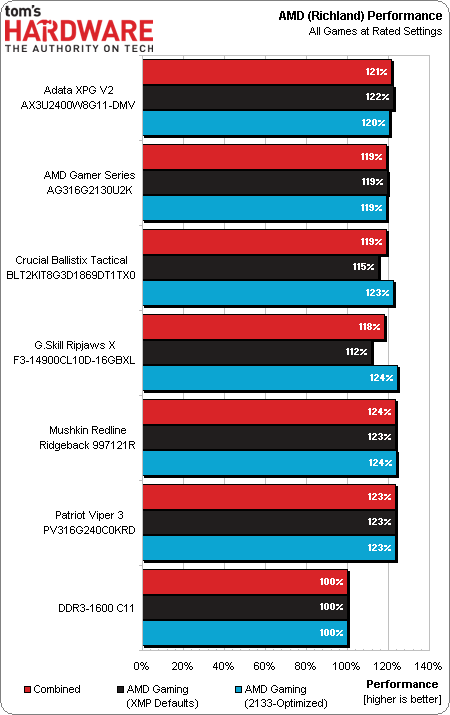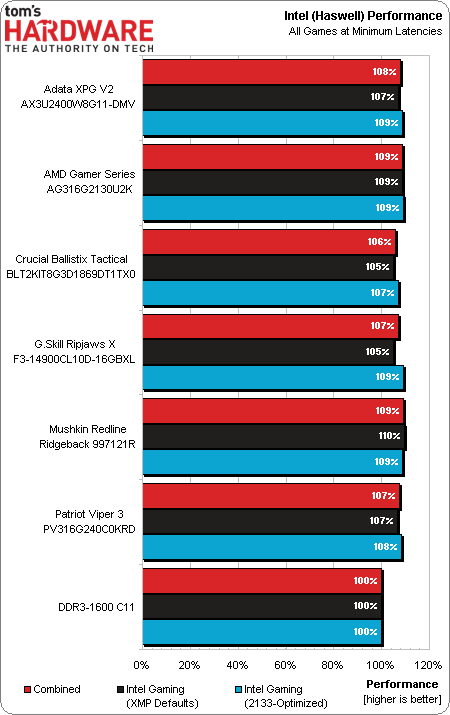Haswell And Richland Memory Scaling: Picking A 16 GB DDR3 Kit
Graphics workloads love fast memory. But how much difference can a desktop-oriented kit have on gaming performance with Intel's HD Graphics 4600 or AMD's Radeon HD 8670D? We test six 16 GB kits, two all the way up to DDR3-2400 to find out.
Overall Performance Scaling
Why you can trust Tom's Hardware
I mentioned DDR3-1600 CAS 11 results throughout the article because this JEDEC standard is the baseline for comparing improved parts. Here’s how that performance difference appears on AMD Richland-based platform.
XMP results aren’t important for Adata and Patriot, since the A10 APU wasn’t stable at DDR3-2400 using any memory kit. More important is that both of these modules achieved similar performance at manually-configured DDR3-2133 settings.
Mushkin is the real performance winner on the AMD platform, pushing a 24% performance improvement compared to standard DDR3-1600 while using nothing more aggressive than its rated settings. G.Skill’s DDR3-1866 CAS 10 might get there less expensively through manual tuning, but manual tuning isn’t guaranteed, either.
Intel’s platform does provide stable operation at up to DDR3-2400 data rates, and even lets us push Patriot’s DDR3-2400 kit to DDR3-2666. But the performance benefits are far less noteworthy, as data rates above 2133 MT/s don't help frame rates.
Mushkin’s DDR3-2133 CAS 9 proves its worth by winning, but with only a 10% gain compared to industry-standard DDR3-1600. G.Skill again gets close to it for far less money, but only if you’re sure the sample you buy will overclock as well as the sample we tested.
Current page: Overall Performance Scaling
Prev Page Results: The Elder Scrolls V: Skyrim Next Page Getting The Most Out Of Richland: Value With A10-6800KGet Tom's Hardware's best news and in-depth reviews, straight to your inbox.
-
Novuake Its a shame the AMD memory controller is so lacking, it matters very little for FX series, but here its a real bummer.Reply
Anyway, I am reasonably sure you could tighten the timings on the Ripjaws considerably, if this is the case with this specific kit, there is NO reason to get the Mushkins...
-
CommentariesAnd More IMO 4GB and 8GB is what most APU Gaming Rigs have. Those looking for an APU for Gaming probably would love results with similar kits. But still we would love these results for like a baseline. Also , the Elite FTW in my next APU build/proposal :DReply -
yannigr You did it again. Another "let's make Intel looks better than it is" article.Reply
How can we give an advantage or two to Intel?
Let's overclock both cpus. So Intel is getting 1GHz extra from it's default frequency while AMD only gets 400MHz. Then we call this fair.
Let's lower the resolution and graphics. That way the benchmarks will be less gpu intensive and Intel's much better cpu will make things look more even.
Not to mention the instability problems with AMD and 2400MHz memory, the problem reaching 4.5GHz. We all know that AMD is unstable and hot. Nice job. You are pros in what you are doing. But off course you where just testing memory here. Yeah right. You lowered the resolution even lower than 1366X768 which is the resolution for hdready displays. I guess lowering the resolution and overclocking was necessary so that Intel gpu can reach 30fps in all tests. Nice work.
Next time try 800X600 and overclock with LN2. -
4Ryan6 ReplyScuttlebutt says that AMD’s A10-6800K reaches 4.5 GHz without much effort, but our sample needed 1.425 V to achieve complete stability. It would easily run 4.4 GHz at 1.30 V, so perhaps 4.5 GHz wasn’t a good target? The problem with 4.4 GHz was that we didn’t want to give the firm a frequency handicap in an article that includes Intel. Our Core i7-4770K was easily running 4.5 GHz at 1.250 V maximum, and we began testing before AMD's sample arrived. And so the test began with the Intel processor at 4.50 GHz, secure in the knowledge that both CPUs would support DDR3-2400 via overclocking. Two of the kits were DDR3-2400-rated. And one of the kits would even run at DDR3-2666.
Thomas, I know it would have involved more work, but wouldn't the right thing to do have been to reset the overclock target to 4.4ghz?
You'd have been in safer territory not to have overclocked at all, if the overclock was not the same for each testing.
Additionally for the record, the very reason some of these overclockers are experiencing such high heat levels are they're overclocking the CPUs memory controller from the very beginning of their overclocking, by attempting to run memory past the design specifications of the CPU right out of the box, that may have been partly the reason you couldn't get past 4.4ghz with acceptable voltage with the A10-6800K.
These memory manufacturers never claimed their memory could be run at higher multiplier overclock levels as they were only tested, and supposedly guaranteed at the stock CPU speed capabilities at the factory, they never guaranteed they would run stably at 45x or beyond, multiplier ranges in the first place.
I have yet to see the first memory claim that BrandX not only can run 2400mhz but can run it at a 50x multiplier for Intel or 25x for AMD, to reach 5.0ghz or for that matter 45x or 22.5x for your 4.5ghz target.
So actually just because you can push the memory to make these tests doesn't mean that running memory speeds way past the CPUs memory controllers design specifications is a safe 24/7 run solution to advise others is seemingly OK, but that is exactly what a lot of users take away from these type of tests.
Just because someone can, doesn't necessarily mean they should, for the longevity of their hardware, isn't THGs responsibility on a higher level than that?
-
de5_Roy woulda liked to see how these kits would perform on a desktop intel hd5000/5100/5200 sku. shame on intel for not making those available on desktop! hd4600 blows!Reply -
Novuake Reply11546494 said:woulda liked to see how these kits would perform on a desktop intel hd5000/5100/5200 sku. shame on intel for not making those available on desktop! hd4600 blows!
I almost think Nvidia and Intel had some nice discussions and deals to keep Iris out of the desktop.
Just a hunch... -
Reynod Nice work crashman ... good to see they still have you chained to the test bench out the back.Reply
I hope they are feeding you buddy and letting you out once in a while !!
Its time they let you loose on another serious overclocking campaign too.
Chris ... get this man a big can of liquid nitrogen, 2 cartons of coke, a box of mars bars and a mobile hot dog vendor for the day ... time to reward crash.
:)


